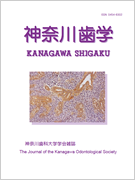- HOME
- > 一般の方
- > バックナンバー:神奈川歯学
- > 42巻2号
- > アブストラクト
アブストラクト(42巻2号:神奈川歯学)

Japanese
| Title : | 日本人の各種指紋型の出現頻度の変遷に対する考察 |
|---|---|
| Subtitle : | 原著 |
| Authors : | 松山永久, 飯村彰, 高橋常男 |
| Authors(kana) : | |
| Organization : | 神奈川歯科大学人体構造学講座・肉眼解剖・臨床解剖学分野 |
| Journal : | 神奈川歯学 |
| Volume : | 42 |
| Number : | 2 |
| Page : | 127-133 |
| Year/Month : | 2007 / 12 |
| Article : | 原著 |
| Publisher : | 神奈川歯科大学学会 |
| Abstract : | 「緒言」指紋は, 掌紋, 足紋と共に皮膚紋理学として位置づけられており, ヒトや指ごとに紋様は全て異なり, "終生不変"という特徴をもっている1). 紋様は臨床医学, 人類遺伝学, 人類学, 法医学などの領域で深く関心が持たれ, 広域に研究されている2~11). 臨床医学では, 皮膚紋理をダウン症, ターナー症候群, クラインフェルター症候群, 先天性筋ジストロフィー症などの遺伝病診断に用いていたが, 現在はPCRによる遺伝子解析の普及により利用されることが少なくなってきている12~29). 法医学では, 個人識別を目的として指紋は犯罪捜査や身元確認で古くから用いられている. 近年, 身元不明死体の個人識別に, 歯科医師が歯牙, スタディモデルやエックス線を利用し個人識別を行っているが, 指紋鑑定を組み合わせることにより, さらに個人識別の精度をあげることは可能である. 2001年の世界貿易センタービルのテロの犠牲者や2004年のスマトラ沖地震によるTSUNAMIの被害者の身元確認にも歯牙所見, DNA分析と共に用いられており, 指紋・歯牙・DNAが身元確認の3大手段とされている. |
| Practice : | 歯科学 |
| Keywords : | 人類学, 指紋, 個人識別, 法医学 |
English
| Title : | A Discussion on the Transition in Appearance of Each Fingerprint Type of Japanese People |
|---|---|
| Subtitle : | |
| Authors : | Nagahisa MATSUYAMA, Akira IIMURA, Tsuneo TAKAHASHI |
| Authors(kana) : | |
| Organization : | Department of Oral Anatomy, Kanagawa Dental College |
| Journal : | Kanagawa Shigaku |
| Volume : | 42 |
| Number : | 2 |
| Page : | 127-133 |
| Year/Month : | 2007 / 12 |
| Article : | Original article |
| Publisher : | Kanagawa Odontological Society |
| Abstract : | Previous research established the frequency distribution of various finger-print types as a function of ethnic group. Since those initial investigations, there has been no subsequent research regarding the distribution of fingerprint types among ethnic Japanese. Since 1960, Western influences, dietary and otherwise, have caused changes in the health and physical characteristics of Japanese people. In this study we used the Friedman test to compare the frequency distribution of fingerprint types in a sample of 100 males and 100 females of Japanese ancestry with the frequency distribution previously reported for this ethnic group. We observed these statistically significant differences : males now have fewer ulnar loops (p<0.01) and more whorls (p<0.01) ; females now have more arches (p<0.05), fewer ulnar loops (p<0.01), and more whorls (p<0.01). In the present Japanese sample, as was earlier shown to be true for all human races, few subjects had the “arch” or “bow” pattern. Our comparison with previous studies shows that there is a trend toward the arch shape becoming more prevalent among females now than in the past. We hypothesize that pharmaceuticals as well as hormone pollutants in the environment have caused this trend. In addition, based on the statistical evidence of the inheritability of distinctive fingerprints patterns, we predict that in the future, as ethnic Japanese people produce offspring with non Japanese people, the distribution of finger-print patterns of the Japanese group will change. |
| Practice : | Dentistry |
| Keywords : |
